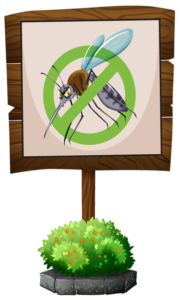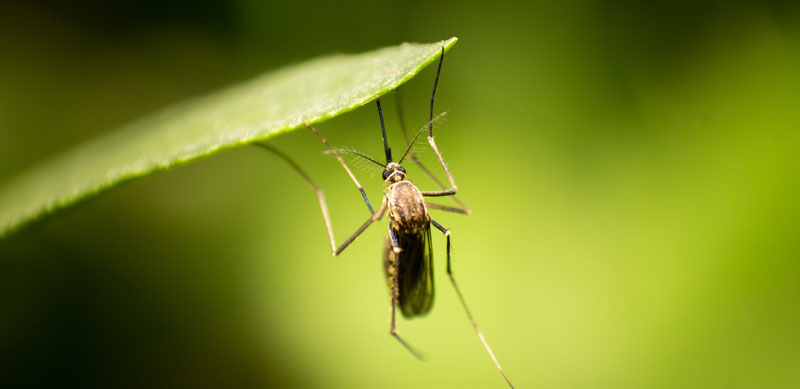MOSQUITO APPLICATION
When referring to the most dangerous animal in the world, usually animals like sharks or alligators come to mind, yet the title belongs to the mosquito. Mosquitoes are estimated to cause between 750 thousand and 1 million human deaths per year.
Although mosquito bites are uncomfortable and may cause itching, there are more serious consequences tied to this animal, like the transmission of serious diseases and viruses, such as Malaria, Dengue, Zika, and West Nile Virus.
These diseases can lead to disabling and possibly deadly effects, such as encephalitis, meningitis, and microcephaly. Malaria alone is responsible for over half a million fatal infections a year.
Engeenuity has proven its effect on mosquitoes not only reducing the eclosion of mosquito eggs to larvae, diminishing total mosquito population, but also increasing the immune response of organisms to Malaria, test which was published in the peer-reviewed Journal of Photochemistry and Photobiology.
“This technology is extremely effective in the control of mosquito reproduction…”
-HML, Inc. Chief-Microbiologist

INDICASAT AIP Malaria Test
Alongside Hoosier Microbiological Laboratories in Muncie, Indiana, USA in 2010, and the Gorgas Institute in Panama in 2012, we have proven our effectiveness in reducing the overall mosquito population by reducing eclosion of mosquito eggs to larvae. We controlled the production of mosquito larvae in open containers in a natural outdoor setting, conducive to the reproduction of mosquitoes, over a three-month period.
In the HML test, twenty grams of micro-organisms and nutrients were added to 7 2-gallon buckets. Three control buckets were left untreated, while four buckets were treated with BioPhoton-X™ water in dosages of 300, 600 and 900 ppm. The buckets were placed 15 feet apart and sat in the open, to then later be compared.
The conclusion by the Chief Microbiologist in charge of HML at the time concluded that BioPhoton-X™ technology reduced the overall production of mosquito larvae by over 60% when compared to controls in this experiment, at all dosage ranges and product strengths. The product is extremely effective in the control of mosquito reproduction. These test results are deemed to be conclusive and reproducible based on Standard Methods.
In the Gorgas Institute test, 6 acrylic trays were divided in 2 groups of 3 (experimental and control). Each group was placed approximately 2 meters away from each other to reduce variables. The control group had 200ml of potable water placed in each tray, while the experimental group had 191ml of water with 9ml of BioPhoton-X™ treated water (4.5% concentration), with 600 Aedes aegypti eggs placed in each tray.
Every 24 hours for a timeframe of 6 days, larvae in each tray were precisely counted. The results of the test were that after 6 days, while the control group had a larvae population of 823, the experimental “BioPhoton-X™” group had a larvae population of 415, an approximate 50% reduction.
The objective of this study was to evaluate the effect of Engeenuity’s Photonic Multiphase Modulators (PMM’s) directly on Plasmodium falciparum cultures or on water that had been treated with BioPhoton-X™ technology and then given to C57BL/6 mice infected with Plasmodium berghei. 
In vitro Exposure
200 ul of cultures infected or not with 1% P. falciparum parasites in schizont stages were used. Engeenuity’s PMM’s were adhered to the bottom of the plates. Plates were left in a 37° incubator overnight and parasitemia was ready the next day.
In vivo Exposure
Male C57BL/6 animals were kept in rooms with light/darkness daily cycles of 12 hours. Activation of the parasite of the Plasmodium berghei ANKA strain, stored in liquid N2 was done through consecutive mouse-to-mouse passages in animals from 6 to 8 weeks old.
Experimental Procedure
Animals were distributed and grouped at random with no more than six animals per cage and were tattooed to monitor the variation in weight throughout the extent of the trial. Thirty animals were used for the first experiment that included different variations of the PMM’s. Water treated with the PMM’s was supplied eight and sixteen days prior to the infection of the animals. The supply of treated water was continued after the infestation of the animals and until the end of the test, as determined by the death of the last animal of the parasitized group without treatment. Engeenuity’s PMM’s were adhered to the outside of the bottles containing the water supply to the cages and were exposed to the ambient light of the animal’s room during the light cycles. The effects of BioPhoton-X™ technology in parasites in culture and in infected mice point to a protective effect on the cells and individuals. Animals that consumed water treated with PMM’s withstood better the attack of the pathogen, evidenced by the not so pronounced weight loss as compared to the untreated controls and a repeated increase in survival. As stated by the chief investigator, these results give hope that with the right manipulation and optimization of the PMM’s, biophotonics can be used to help combat diseases.




